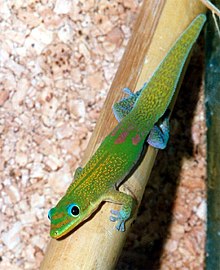
Back أبو بريص Arabic برص ARZ Cekcek BAN Boraspati BBC Burubuaya BCL Cecek BEW Gekuloj Esperanto گکو Persian Họmẹsì GUW Tsaka Hausa
| Gecko | |
|---|---|

| |
| Gold dust day gecko | |
| Scientific classification | |
| Domain: | Eukaryota |
| Kingdom: | Animalia |
| Phylum: | Chordata |
| Class: | Reptilia |
| Order: | Squamata |
| Clade: | Gekkonomorpha |
| Infraorder: | Gekkota Cuvier, 1817 |
| Subgroups | |
Geckos are small, mostly carnivorous lizards that have a wide distribution, found on every continent except Antarctica. Belonging to the infraorder Gekkota, geckos are found in warm climates throughout the world. They range from 1.6 to 60 centimetres (0.6 to 23.6 inches).
Geckos are unique among lizards for their vocalisations, which differ from species to species. Most geckos in the family Gekkonidae use chirping or clicking sounds in their social interactions. Tokay geckos (Gekko gecko) are known for their loud mating calls, and some other species are capable of making hissing noises when alarmed or threatened. They are the most species-rich group of lizards, with about 1,500 different species worldwide.[2]
All geckos, except species in the family Eublepharidae lack eyelids; instead, the outer surface of the eyeball has a transparent membrane, the brille. They have a fixed lens within each iris that enlarges in darkness to let in more light. Since they cannot blink, species without eyelids generally lick their own brilles when they need to clear them of dust and dirt, in order to keep them clean and moist.[3]
Unlike most lizards, geckos are usually nocturnal[4] and have excellent night vision; their colour vision in low light is 350 times more sensitive than human eyes.[5] The nocturnal geckos evolved from diurnal species, which had lost the rod cells from their eyes. The gecko eye, therefore, modified its cone cells that increased in size into different types, both single and double. Three different photo-pigments have been retained, and are sensitive to ultraviolet, blue, and green. They also use a multifocal optical system that allows them to generate a sharp image for at least two different depths.[6][7] While most gecko species are nocturnal, some species are diurnal and active during the day, which have evolved multiple times independently.[4]
Many species are well known for their specialised toe pads, which enable them to grab and climb onto smooth and vertical surfaces, and even cross indoor ceilings with ease. Geckos are well known to people who live in warm regions of the world, where several species make their home inside human habitations. These, for example the house gecko, become part of the indoor menagerie and are often welcomed, as they feed on insect pests; including moths and mosquitoes. Like most lizards, geckos can lose their tails in defence, a process called autotomy; the predator may attack the wriggling tail, allowing the gecko to escape.[8]
The largest species, Gigarcanum delcourti, is only known from a single, stuffed specimen probably collected in the 19th century found in the basement of the Natural History Museum of Marseille in Marseille, France. This gecko was 600 millimetres (24 inches) long, and it was likely endemic to New Caledonia, where it lived in native forests.[9] The smallest gecko, the Jaragua sphaero, is a mere 16 millimetres (0.63 inches) long, and was discovered in 2001 on a small island off the coast of Hispaniola.[10]
- ^ Villa, Andrea; Wings, Oliver; Rabi, Márton (2022). Angielczyk, Kenneth (ed.). "A new gecko (Squamata, Gekkota) from the Eocene of Geiseltal (Germany) implies long-term persistence of European Sphaerodactylidae" (PDF). Papers in Palaeontology. 8 (3). Bibcode:2022PPal....8E1434V. doi:10.1002/spp2.1434. ISSN 2056-2799. S2CID 249358350.
- ^ "Search results – gecko". Reptile-Database.Reptarium.cz. The Reptile Database. Archived from the original on 2020-11-27. Retrieved 2022-02-01.
- ^ Badger, David (2006). Lizards: a Natural History of Some Uncommon Creatures. St. Paul, MN: Voyageur Press. p. 47. ISBN 978-0760325797.
- ^ a b Gamble, T.; Greenbaum, E.; Jackman, T.R.; Bauer, A.M. (August 2015). "Into the light: Diurnality has evolved multiple times in geckos". Biological Journal of the Linnean Society. 115 (4): 896–910. doi:10.1111/bij.12536.
- ^ Roth, L.S.V.; Lundstrom, L.; Kelber, A.; Kroger, R.H.H.; Unsbo, P. (1 March 2009). "The pupils and optical systems of gecko eyes". Journal of Vision. 9 (3): 27.1–11. doi:10.1167/9.3.27. PMID 19757966.
- ^ Roth, Lina S. V.; Lundström, Linda; Kelber, Almut; Kröger, Ronald H. H.; Unsbo, Peter (1 March 2009). "The pupils and optical systems of gecko eyes". Journal of Vision. 9 (3): 27.1–11. doi:10.1167/9.3.27. PMID 19757966.
- ^ "Gecko-inspired multifocal contact lenses, cameras on the anvil". News.OneIndia.in. 8 May 2009. Archived from the original on 28 March 2017. Retrieved 1 February 2022.
- ^ Mihai, Andrei (9 September 2009). "Gecko tail has a mind of its own". www.ZMEScience.com. ZME Science. Archived from the original on 30 November 2009. Retrieved 1 February 2022.
- ^ Heinicke, Matthew P.; Nielsen, Stuart V.; Bauer, Aaron M.; Kelly, Ryan; Geneva, Anthony J.; Daza, Juan D.; Keating, Shannon E.; Gamble, Tony (2023-06-19). "Reappraising the evolutionary history of the largest known gecko, the presumably extinct Hoplodactylus delcourti, via high-throughput sequencing of archival DNA". Scientific Reports. 13 (1): 9141. Bibcode:2023NatSR..13.9141H. doi:10.1038/s41598-023-35210-8. ISSN 2045-2322. PMC 10279644. PMID 37336900.
- ^ Piper, Ross (2007). Extraordinary Animals: an Encyclopedia of Curious and Unusual Animals. Westport, Conn.: Greenwood Press. p. 143. ISBN 978-0313339226.
© MMXXIII Rich X Search. We shall prevail. All rights reserved. Rich X Search